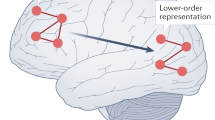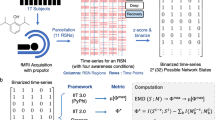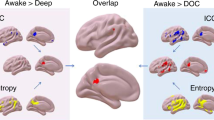Abstract
In this Opinion article, we discuss how integrated information theory accounts for several aspects of the relationship between consciousness and the brain. Integrated information theory starts from the essential properties of phenomenal experience, from which it derives the requirements for the physical substrate of consciousness. It argues that the physical substrate of consciousness must be a maximum of intrinsic cause–effect power and provides a means to determine, in principle, the quality and quantity of experience. The theory leads to some counterintuitive predictions and can be used to develop new tools for assessing consciousness in non-communicative patients.
This is a preview of subscription content, access via your institution
Access options
Subscribe to this journal
Receive 12 print issues and online access
$189.00 per year
only $15.75 per issue
Buy this article
- Purchase on Springer Link
- Instant access to full article PDF
Prices may be subject to local taxes which are calculated during checkout




Similar content being viewed by others
References
Oizumi, M., Albantakis, L. & Tononi, G. From the phenomenology to the mechanisms of consciousness: integrated information theory 3.0. PLoS Comput. Biol. 10, e1003588 (2014).
Tononi, G. The integrated information theory of consciousness: an updated account. Arch. Ital. Biol. 150, 56–90 (2012).
Tononi, G. Integrated information theory. Scholarpedia http://dx.doi.org/10.4249/scholarpedia.4164 (2015).
Posner, J. B., Saper, C. B., Schiff, N. D. & Plum, F. Diagnosis of Stupor and Coma (Oxford Univ. Press, 2007).
Koch, C., Massimini, M., Boly, M. & Tononi, G. The neural correlates of consciousness: progress and problems. Nat. Rev. Neurosci. 17, 307–321 (2016).
Boly, M. et al. Consciousness in humans and non-human animals: recent advances and future directions. Front. Psychol. 4, 625 (2013).
Lemon, R. N. & Edgley, S. A. Life without a cerebellum. Brain 133, 652–654 (2010).
Yu, F., Jiang, Q. J., Sun, X. Y. & Zhang, R. W. A new case of complete primary cerebellar agenesis: clinical and imaging findings in a living patient. Brain 138, e353 (2015).
Tononi, G. & Koch, C. Consciousness: here, there, and everywhere? Phil. Trans. R. Soc. B 370, 20140167 (2015).
Chalmers, D. J. Facing up to the problem of consciousness. J. Conscious. Studies 2, 200–219 (1995).
Tononi, G. An information integration theory of consciousness. BMC Neurosci. 5, 42 (2004).
Tononi, G. Consciousness as integrated information: a provisional manifesto. Biol. Bull. 215, 216–242 (2008).
Descartes, R. Discourse on Method and Meditations on First Philosophy (Hackett, 1998).
Pöppel, E. Mindworks: Time and Conscious Experience (Harcourt Brace Jovanovich, 1988).
Holcombe, A. O. Seeing slow and seeing fast: two limits on perception. Trends Cogn. Sci. 13, 216–221 (2009).
Bachmann, T. Microgenetic Approach to the Conscious Mind (John Benjamins, 2000).
Kim, J. Multiple realization and the metaphysics of reduction. Philos. Phenomenol. Res. 52, 1–26 (1992).
Hoel, E. P., Albantakis, L. & Tononi, G. Quantifying causal emergence shows that macro can beat micro. Proc. Natl Acad. Sci. USA 110, 19790–19795 (2013).
Alivisatos, A.P. et al. The brain activity map project and the challenge of functional connectomics. Neuron 74, 970–974 (2012).
Buzsáki, G. Neural syntax: cell assemblies, synapsembles, and readers. Neuron 68, 362–385 (2010).
Li, C. Y., Poo, M. M. & Dan, Y. Burst spiking of a single cortical neuron modifies global brain state. Science 324, 643–646 (2009).
London, M., Roth, A., Beeren, L., Häusser, M. & Latham, P. E. Sensitivity to perturbations in vivo implies high noise and suggests rate coding in cortex. Nature 466, 123–127 (2010).
Boly, M. et al. Stimulus set meaningfulness and neurophysiological differentiation: a functional magnetic resonance imaging study. PLoS ONE 10, e0125337 (2015).
Boly, M. et al. Brain connectivity in disorders of consciousness. Brain Connect. 2, 1–10 (2012).
Seth, A. K., Barrett, A. B. & Barnett, L. Causal density and integrated information as measures of conscious level. Philos. Trans. A Math. Phys. Eng. Sci. 369, 3748–3767 (2011).
Deco, G., Hagmann, P., Hudetz, A. G. & Tononi, G. Modeling resting-state functional networks when the cortex falls asleep: local and global changes. Cereb. Cortex 24, 3180–3194 (2014).
von Arx, S. W., Muri, R. M., Heinemann, D., Hess, C. W. & Nyffeler, T. Anosognosia for cerebral achromatopsia — a longitudinal case study. Neuropsychologia 48, 970–977 (2010).
Goldberg, I. I., Harel, M. & Malach, R. When the brain loses its self: prefrontal inactivation during sensorimotor processing. Neuron 50, 329–339 (2006).
Steriade, M., Timofeev, I. & Grenier, F. Natural waking and sleep states: a view from inside neocortical neurons. J. Neurophysiol. 85, 1969–1985 (2001).
Nir, Y. et al. Regional slow waves and spindles in human sleep. Neuron 70, 153–169 (2011).
Siclari, F., LaRocque, J. J., Bernardi, G., Postle, B. R. & Tononi, G. The neural correlates of consciousness in sleep: a no-task, within-state paradigm. BioRXivhttp://dx.doi.org/10.1101/012443 (2014).
Sperry, R. W. in Neuroscience 3rd Study Program (eds Schmitt, F. O. & Worden, F. G.) 5–19 (MIT Press, 1974).
Gazzaniga, M. S. Forty-five years of split-brain research and still going strong. Nat. Rev. Neurosci. 6, 653–659 (2005).
Berlin, H. A. The neural basis of the dynamic unconscious. Neuropsychoanalysis 13, 1–68 (2011).
Mudrik, L., Breska, A., Lamy, D. & Deouell, L. Y. Integration without awareness: expanding the limits of unconscious processing. Psychol. Sci. 22, 764–770 (2011).
Mudrik, L., Faivre, N. & Koch, C. Information integration without awareness. Trends Cogn. Sci. 18, 488–496 (2014).
Lamme, V. A. & Roelfsema, P. R. The distinct modes of vision offered by feedforward and recurrent processing. Trends Neurosci. 23, 571–579 (2000).
Harris, K. D. & Shepherd, G. M. The neocortical circuit: themes and variations. Nat. Neurosci. 18, 170–181 (2015).
Miller, G. A. The magical number seven, plus or minus two: some limits on our capacity for processing information. Psychol. Rev. 63, 81–97 (1956).
Norretranders, T. The User Illusion: Cutting Consciousness Down to Size (Viking Penguin, 1991).
Sperling, G. The information available in brief visual presentations. Psychol. Monogr. 74, 1–29 (1960).
Cohen, M. A. & Dennett, D. C. Consciousness cannot be separated from function. Trends Cogn. Sci. 15, 358–364 (2011).
Cohen, M. A. & Dennett, D. C. Response to Fahrenfort and Lamme: defining reportability, accessibility and sufficiency in conscious awareness. Trends Cogn. Sci. 16, 139–140 (2012).
O'Regan, J. K., Rensink, R. A. & Clark, J. J. Change-blindness as a result of 'mudsplashes'. Nature 398, 34–34 (1999).
Dehaene, S. Consciousness and the Brain: Deciphering How the Brain Codes our Thoughts (Penguin, 2014).
Kouider, S., de Gardelle, V., Sackur, J. & Dupoux, E. How rich is consciousness? The partial awareness hypothesis. Trends Cogn. Sci. 14, 301–307 (2010).
Block, N. On a confusion about a function of consciousness. Behav. Brain Sci. 18, 227–287 (1995).
Block, N. Perceptual consciousness overflows cognitive access. Trends Cogn. Sci. 15, 567–575 (2011).
Lamme, V. A. How neuroscience will change our view on consciousness. Cogn. Neurosci. 1, 204–220 (2010).
Bronfman, Z. Z., Brezis, N., Jacobson, H. & Usher, M. We see more than we can report: “cost free” color phenomenality outside focal attention. Psychol. Sci. 25, 1394–1403 (2014).
Wolfe, J. in Fleeting Memories (ed. Coltheart, V.) 71–94 (MIT Press, 2000).
Felleman, D. J. & Van Essen, D. C. Distributed hierarchical processing in the primate cerebral cortex. Cereb. Cortex 1, 1–47 (1991).
Riesenhuber, M. & Poggio, T. Hierarchical models of object recognition in cortex. Nat. Neurosci. 2, 1019–1025 (1999).
Franzius, M., Sprekeler, H. & Wiskott, L. Slowness and sparseness lead to place, head-direction, and spatial-view cells. PLoS Comput. Biol. 3, e166 (2007).
Spratling, M. W. Learning posture invariant spatial representations through temporal correlations. IEEE Trans. Autonom. Ment. Dev. 1, 253–263 (2009).
Treisman, A. The binding problem. Curr. Opin. Neurobiol. 6, 171–178 (1996).
Baddeley, A. D. Working Memory (Clarendon Press, 1986).
Herculano-Houzel, S. The remarkable, yet not extraordinary, human brain as a scaled-up primate brain and its associated cost. Proc. Natl Acad. Sci. USA 109 (Suppl. 1), 10661–10668 (2012).
Jain, S. K. et al. Bilateral large traumatic basal ganglia haemorrhage in a conscious adult: a rare case report. Brain Inj. 27, 500–503 (2013).
Straussberg, R. et al. Familial infantile bilateral striatal necrosis: clinical features and response to biotin treatment. Neurology 59, 983–989 (2002).
Caparros-Lefebvre, D., Destee, A. & Petit, H. Late onset familial dystonia: could mitochondrial deficits induce a diffuse lesioning process of the whole basal ganglia system? J. Neurol. Neurosurg. Psychiatry 63, 196–203 (1997).
Pigorini, A. et al. Bistability breaks-off deterministic responses to intracortical stimulation during non-REM sleep. Neuroimage 112, 105–113 (2015).
Blumenfeld, H. Impaired consciousness in epilepsy. Lancet Neurol. 11, 814–826 (2012).
Friston, K. The free-energy principle: a unified brain theory? Nat. Rev. Neurosci. 11, 127–138 (2010).
Edlund, J. A. et al. Integrated information increases with fitness in the evolution of animats. PLoS Comput. Biol. 7, e1002236 (2011).
Albantakis, L., Hintze, A., Koch, C., Adami, C. & Tononi, G. Evolution of integrated causal structures in animats exposed to environments of increasing complexity. PLoS Comput. Biol. 10, e1003966 (2014).
Massimini, M. et al. Breakdown of cortical effective connectivity during sleep. Science 309, 2228–2232 (2005).
Casali, A. G. et al. A theoretically based index of consciousness independent of sensory processing and behavior. Sci. Transl Med. 5, 198ra105 (2013).
Massimini, M. et al. Cortical reactivity and effective connectivity during REM sleep in humans. Cogn. Neurosci. 1, 176–183 (2010).
Sarasso, S. et al. Consciousness and complexity during unresponsiveness induced by propofol, xenon, and ketamine. Curr. Biol. 25, 3099–3105 (2015).
Barrett, A. B. & Seth, A. K. Practical measures of integrated information for time-series data. PLoS Comput. Biol. 7, e1001052 (2011).
Oizumi, M., Amari, S., Yanagawa, T., Fujii, N. & Tsuchiya, N. Measuring integrated information from the decoding perspective. PLoS Comput Biol 12, e1004654 (2015).
Hudetz, A. G., Liu, X. & Pillay, S. Dynamic repertoire of intrinsic brain states is reduced in propofol-induced unconsciousness. Brain Connect. 5, 10–22 (2015).
Barttfeld, P. et al. Signature of consciousness in the dynamics of resting-state brain activity. Proc. Natl Acad. Sci. USA 112, 887–892 (2015).
Tagliazucchi, E. et al. Large-scale signatures of unconsciousness are consistent with a departure from critical dynamics. J. R. Soc. Interface 13, 20151027 (2016).
Sullivan, P. R. Contentless consciousness and information-processing theories of mind. Philos. Psychiatry Psychol. 2, 51–59 (1995).
Baars, B. A. Cognitive Theory of Consciousness (Cambridge Univ. Press, 1988).
Dehaene, S. & Changeux, J.-P. Experimental and theoretical approaches to conscious processing. Neuron 70, 200–227 (2011).
Steriade, M. The corticothalamic system in sleep. Front. Biosci. 8, d878-99 (2003).
Searle, J. Can information theory explain consciousness? New York Review of Books (10 Jan 2013).
Acknowledgements
The authors thank L. Albantakis, C. Cirelli, L. Ghilardi, W. Marshall, W. Mayner, A. Mensen, M. Oizumi, U. Olcese, B. Postle, S. Sasai and other colleagues for their various contributions to the work presented here. This work was supported by the Templeton World Charity Foundation, the McDonnell Foundation and the Distinguished Chair in Consciousness Science (University of Wisconsin) (to G.T.), and by the James S. McDonnell Scholar Award 2013 (to M.M.).
Author information
Authors and Affiliations
Corresponding author
Ethics declarations
Competing interests
The authors declare no competing financial interests.
Related links
FURTHER INFORMATION
Supplementary information
Supplementary information S1 (figure)
Axioms and postulates of IIT. (PDF 340 kb)
Supplementary information S2 (box)
IIT Pseudocode (PDF 135 kb)
Supplementary information S3 (figure)
Integrated information, neuroanatomy and neurophysiology. (PDF 219 kb)
Supplementary information S4 (box)
Neuronal bistability impairs information integration during slow wave sleep (PDF 842 kb)
Supplementary information S5 (box)
IIT and other theories of consciousness (PDF 322 kb)
Glossary
- Achromatopsia
-
A condition in which a person is unable to perceive colours.
- Anosognosia
-
A condition in which a person has a neurological deficit, but is unaware of it.
- Axioms
-
Properties that are self-evident and essential; in integrated information theory, those that are true of every possible experience — namely, intrinsic existence, composition, information, integration and exclusion.
- Background conditions
-
Factors that enable consciousness, such as neuromodulators and external inputs that maintain adequate excitability.
- Cause–effect repertoire
-
The probability distribution of potential past and future states of a system that is specified by a mechanism in its current state.
- Cause–effect space
-
A space with each axis representing the probability of each possible past and future state of a system.
- Cause–effect structure
-
The set of cause–effect repertoires specified by all the mechanisms of a system in its current state.
- Complex
-
A set of elements in a state that specifies a conceptual structure corresponding to a maximum of integrated information (Φmax). A complex is thus a physical substrate of consciousness.
- Concepts
-
The cause–effect repertoires specified by a mechanism that is maximally irreducible (Φmax).
- Conceptual structure
-
The set of all concepts specified by a system of elements in a state with their respective Φmax values, which can be plotted as a set of points in cause–effect space.
- Content-specific NCC
-
Neural elements, the activity of which determines a particular content of experience.
- Elements
-
The minimum constituents of a system that have at least two different states (for example, being on or off), inputs that can affect those states and outputs that depend on them.
- Full NCC
-
The neural elements constituting the physical substrate of consciousness, irrespective of its specific content.
- Integrated information
-
(Denoted Φ). Information that is specified by a system that is irreducible to that specified by its parts. It is calculated as the distance between the conceptual structure specified by the intact system and that specified by its minimum information partition.
- Mechanism
-
Any subset of elements within a system that has cause–effect power on it (that is, that constrains its cause–effect space).
- Neural correlates of consciousness
-
(NCC). The minimum neuronal mechanisms jointly sufficient for any one specific conscious experience.
- Postulates
-
Properties of experience that are derived from the axioms of integrated information theory and that must be satisfied by the physical substrate of consciousness — namely, to be a maximum of irreducible, specific, compositional, intrinsic cause–effect power (intrinsic cause–effect power for short).
- Purviews
-
The subsets of elements of a complex, the past and future states of which are constrained by a mechanism specifying a concept.
- Qualia
-
The qualitative feeling of phenomenal distinctions within an experience (for example, seeing a colour, hearing a sound or feeling a pain).
- Relations
-
Maximally irreducible overlaps among the purviews of two or more concepts.
Rights and permissions
About this article
Cite this article
Tononi, G., Boly, M., Massimini, M. et al. Integrated information theory: from consciousness to its physical substrate. Nat Rev Neurosci 17, 450–461 (2016). https://doi.org/10.1038/nrn.2016.44
Published:
Issue Date:
DOI: https://doi.org/10.1038/nrn.2016.44
This article is cited by
-
Macroscale coupling between structural and effective connectivity in the mouse brain
Scientific Reports (2024)
-
Global Versus Local Theories of Consciousness and the Consciousness Assessment Issue in Brain Organoids
Neuroethics (2024)
-
Examining Phronesis Models with Evidence from the Neuroscience of Morality Focusing on Brain Networks
Topoi (2024)
-
The Donation of Human Biological Material for Brain Organoid Research: The Problems of Consciousness and Consent
Science and Engineering Ethics (2024)
-
Patentability of Brain Organoids derived from iPSC– A Legal Evaluation with Interdisciplinary Aspects
Neuroethics (2024)



